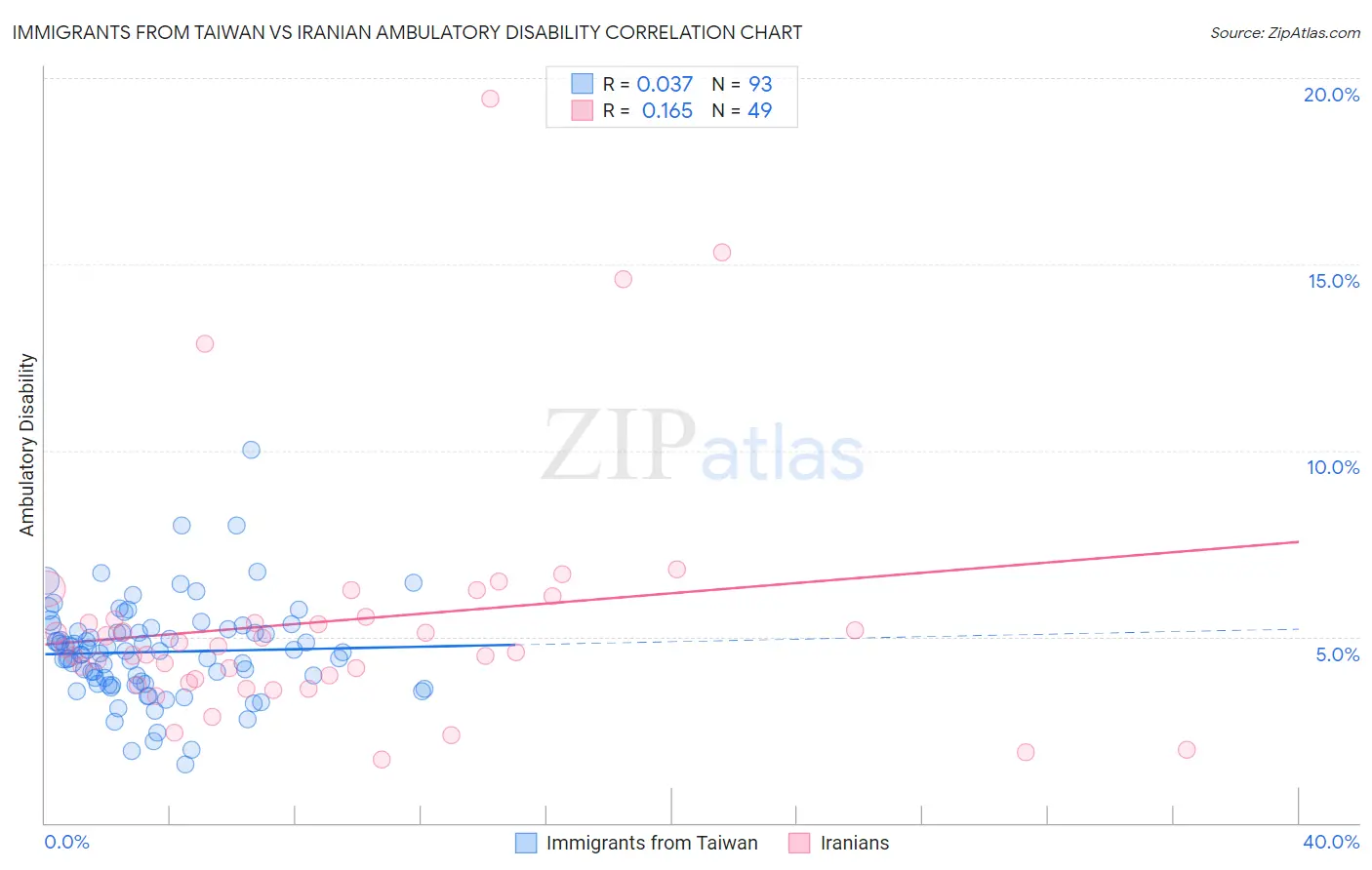Immigrants from Taiwan vs Iranian Ambulatory Disability
COMPARE
Immigrants from Taiwan
Iranian
Ambulatory Disability
Ambulatory Disability Comparison
Immigrants from Taiwan
Iranians
4.9%
AMBULATORY DISABILITY
100.0/ 100
METRIC RATING
4th/ 347
METRIC RANK
5.1%
AMBULATORY DISABILITY
100.0/ 100
METRIC RATING
9th/ 347
METRIC RANK
Immigrants from Taiwan vs Iranian Ambulatory Disability Correlation Chart
The statistical analysis conducted on geographies consisting of 298,204,789 people shows no correlation between the proportion of Immigrants from Taiwan and percentage of population with ambulatory disability in the United States with a correlation coefficient (R) of 0.037 and weighted average of 4.9%. Similarly, the statistical analysis conducted on geographies consisting of 316,801,609 people shows a poor positive correlation between the proportion of Iranians and percentage of population with ambulatory disability in the United States with a correlation coefficient (R) of 0.165 and weighted average of 5.1%, a difference of 3.9%.

Ambulatory Disability Correlation Summary
| Measurement | Immigrants from Taiwan | Iranian |
| Minimum | 1.6% | 1.7% |
| Maximum | 10.0% | 19.5% |
| Range | 8.4% | 17.7% |
| Mean | 4.6% | 5.4% |
| Median | 4.6% | 4.7% |
| Interquartile 25% (IQ1) | 3.7% | 3.8% |
| Interquartile 75% (IQ3) | 5.2% | 5.5% |
| Interquartile Range (IQR) | 1.4% | 1.7% |
| Standard Deviation (Sample) | 1.3% | 3.4% |
| Standard Deviation (Population) | 1.3% | 3.3% |
Demographics Similar to Immigrants from Taiwan and Iranians by Ambulatory Disability
In terms of ambulatory disability, the demographic groups most similar to Immigrants from Taiwan are Thai (4.9%, a difference of 0.24%), Immigrants from Singapore (5.0%, a difference of 1.4%), Filipino (4.9%, a difference of 1.4%), Immigrants from Bolivia (5.0%, a difference of 2.1%), and Bolivian (5.1%, a difference of 2.5%). Similarly, the demographic groups most similar to Iranians are Immigrants from South Central Asia (5.1%, a difference of 0.36%), Yup'ik (5.2%, a difference of 0.60%), Bolivian (5.1%, a difference of 1.4%), Immigrants from Bolivia (5.0%, a difference of 1.7%), and Immigrants from Korea (5.2%, a difference of 2.2%).
| Demographics | Rating | Rank | Ambulatory Disability |
| Immigrants | India | 100.0 /100 | #1 | Exceptional 4.8% |
| Filipinos | 100.0 /100 | #2 | Exceptional 4.9% |
| Thais | 100.0 /100 | #3 | Exceptional 4.9% |
| Immigrants | Taiwan | 100.0 /100 | #4 | Exceptional 4.9% |
| Immigrants | Singapore | 100.0 /100 | #5 | Exceptional 5.0% |
| Immigrants | Bolivia | 100.0 /100 | #6 | Exceptional 5.0% |
| Bolivians | 100.0 /100 | #7 | Exceptional 5.1% |
| Immigrants | South Central Asia | 100.0 /100 | #8 | Exceptional 5.1% |
| Iranians | 100.0 /100 | #9 | Exceptional 5.1% |
| Yup'ik | 100.0 /100 | #10 | Exceptional 5.2% |
| Immigrants | Korea | 100.0 /100 | #11 | Exceptional 5.2% |
| Okinawans | 100.0 /100 | #12 | Exceptional 5.3% |
| Burmese | 100.0 /100 | #13 | Exceptional 5.3% |
| Immigrants | Eastern Asia | 100.0 /100 | #14 | Exceptional 5.3% |
| Immigrants | China | 100.0 /100 | #15 | Exceptional 5.3% |
| Immigrants | Hong Kong | 100.0 /100 | #16 | Exceptional 5.3% |
| Immigrants | Ethiopia | 100.0 /100 | #17 | Exceptional 5.4% |
| Immigrants | Sri Lanka | 100.0 /100 | #18 | Exceptional 5.4% |
| Indians (Asian) | 100.0 /100 | #19 | Exceptional 5.4% |
| Ethiopians | 100.0 /100 | #20 | Exceptional 5.4% |